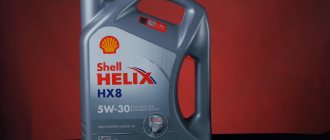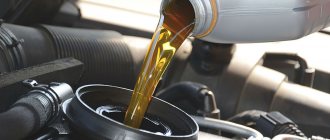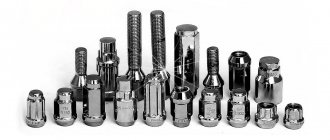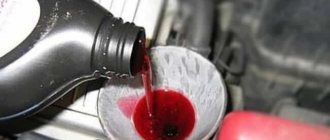07/19/2021 23 361 Lubrication system
Author: Ivan Baranov
Almost all well-known companies specializing in the production of lubricants offer their customers products of exceptionally high quality, which have proven themselves over the years. In this article we will try to figure out which specific oil is best for the gearbox of your car.
[Hide]
How to choose gearbox oil?
Selecting the right gearbox oil is a rather difficult process. First of all, you must follow the instructions of the car manufacturer. All necessary information is contained in the manual in the chapter “Lubrication system”.
Synthetic transmission fluids are much better in their characteristics than mineral ones; they are excellent for reliable protection of mechanisms that experience heavy loads. But the price is much higher than the mineral one. If you need to save money, you can use semi-synthetics. But do not forget: under no circumstances should you mix mineral water and synthetics; if necessary, you can only mix liquids with the same markings!
Transmission fluids from Motul and Castrol
Fluids for manual transmissions are classified primarily by viscosity level (SAE), as well as by the level of compliance with the conditions in which the vehicle is operated (APL).
In turn, the SAE classification is divided into three categories:
- winter transmission fluid (70W, 75W, 80W and 85W);
- summer transmission fluid (80W, 85W, 90W, 140W and 250W);
- all-season transmission fluid (75W–90, 80W–140).
Transmission lubricants from the manufacturer Elf Tranself EP 80W-90
As for the APL classification, it in turn is divided into 7 groups, but GL–4 and GL–5 are considered the most common:
- GL–4 is well suited if the gearbox is operated under light loads;
- GL–5 is designed for extremely harsh conditions.
By the way, you can notice that on our roads the most ordinary operation of a car can easily become extremely extreme, since low quality fuel, high dust levels and long winters significantly accelerate various processes occurring in the oil, which means that its lubricating properties are quickly lost.
If we talk about oils used in automatic transmissions, then there are no strictly defined rules for them. Major car manufacturers have formed their own standards for ATF.
But if you are confused or afraid of making a mistake, then there is another correct method of determination. You can always find out what kind of oil to pour into the box at your car's service station.
Selection of oil by car brand
Manol FWD Getriebeoel and Lukoil 75W-85 TM-4
One of the main and most correct options for selecting transmission fluid is a thorough study of the service and operation instructions for the vehicle, it comes with the car. You just need to find the item you need, find out the brand of liquid and purchase it. The correct selection of oil has a very serious impact on the performance of the car; if you choose the wrong one, you can easily damage it or significantly reduce the service life of individual parts and components. As a result, we will try to approach the issue of choosing transmission fluid extremely seriously. First of all, you should choose from those liquids recommended by the manufacturer.
AvtoVAZ recommends the following oil for cars of its own production:
- gear oil OMSKOIL TRANS P (indices 80W-85; GL-4/5);
- transmission oil VOLNEZ TM4 (indices 80W-90; GL-4);
- gear oil REXOL T (indices 80W-85; GL-4).
From foreign ones, any that corresponds to GL-3 or higher is suitable, but in this case, nowadays it is easy to buy fake oil instead of the original one. Spirax S5 ATE 75W90 GL4/5 oil from Shell has proven itself to be excellent.
Owners of Daewoo Lanos and Daewoo Nexia cars, according to the instructions, should use SAE 80W GL-4, 75W-90 GL-4 oil, but only if the temperature does not drop below 30.
Which brand of oil is better?
Currently, all companies, both Russian and foreign, are trying to produce transmission fluid only of the highest quality and therefore determining the best is quite problematic. The best brand of oil is the one recommended by the manufacturer of a particular car. It is also worth giving preference to the most well-known brands that have many years of experience in the production of lubricants.
Gearbox lubricant from Lukoil TM-5 and ZIC G-FF
Selection of engine oil by car brand: additional recommendations
In most cases, our service offers several modifications of lubricants. You can select a suitable product based on some technical parameters:
- Viscosity. This parameter is responsible for the ability to use oil in different weather conditions. For example, a lubricant with an index of 5W-30 guarantees engine starting at a temperature of -30 degrees Celsius.
- Oil type. There are several types of lubricants, including synthetic, semi-synthetic and mineral. In this case, the selection of oil can be done based on the mileage of the car. For example, for worn-out engines it is better to choose a semi-synthetic model.
You can get advice on the selection of lubricants and oil filters by car brand by calling +7 (812) 777-04-33.
Is engine oil suitable for the gearbox?
As a rule, only transmission fluids should be used for gearboxes. But there are exceptions, for example, such well-known companies as Honda, Peugeot and Chrysler advise pouring motor oils into the box. Still, we would advise not to take risks, since transmission oils have a denser consistency than motor oils and there is great doubt that they will be 100% able to cope with the functions assigned to them. We must also not forget that different types of automotive transmission fluids, ATF and MTF, are used for manual and automatic transmissions.
Oil marking
Oils differ from each other not only in the origin of the basic components and chemical composition.
The choice of engine oil or transmission fluid should also be made taking into account the recommended temperature-viscosity characteristics and application conditions.
What does this mean?
This means that the manufacturer allows the use of oil from any manufacturer, of any origin of the base components. However, it must meet certain requirements of API and SAE standards.
SAE
This standard classifies the entire group of oils according to their viscosity-temperature characteristics.
According to SAE, all oils are divided into three main groups - winter, summer and all-season.
The designation of winter oils includes a number followed by the letter “W” and shows at what negative temperatures they will maintain a viscosity sufficient for easy starting and operation of the engine.
Summer oils are used exclusively at positive ambient temperatures. They are indicated only by numbers. Motor fluids are designated by numbers from 0 to 60.
All-season ones have a double designation in the form of a number with the letter W and another number. These oils are designed to work at both negative and positive temperatures, therefore they do not require seasonal replacement and are the most common.
API
This standard was developed by the American Petroleum Institute and was given the acronym API.
Based on the results of tests carried out on benches or real engines, it divides motor oils into three main classes - for gasoline, for diesel engines or for two-stroke engines.
The first letter in the API designation indicates precisely this class: S - for gasoline engine oils, C - diesel, T - two-stroke.
The second letter indicates the quality class and area of application.
For gasoline engines, oils are classified as follows:
- SC - for engines produced before 1964.
- SD – for internal combustion engines produced between 1964 and 1968
- SE – for engines from 1969 to 1972.
- SF - for engines from 1973 to 1988
- SG - for engines produced from 1989 to 1994
- SH – for engines manufactured 1995-1996.
- SJ – for engines 1997-2000.
- SL – for internal combustion engines produced from 2001 to 2003.
- SM – for engines produced since 2004.
- SN – for modern engines with exhaust gas aftertreatment catalysts
For diesel internal combustion engines, the letter designation of the categories is slightly different:
- CB – for engines up to 1961.
- CC – for engines from 1961 to 1983.
- CE - for turbocharged engines from 1983 to 1990.
- CF – for turbocharged engines from 1990 to 1994.
- CG-4 - for turbocharged engines from 1994 to 1998.
- CH-4 – for engines from 1998 onwards.
- CI-4 – for modern turbocharged internal combustion engines
- CI-4plus - for advanced turbocharged engines
API CJ - this classification has been licensed since October 2006 and is intended for engines produced in 2007 and equipped with exhaust emission reduction systems.
Characteristics
Before talking about the best oil for a certain brand of car, you need to get acquainted with the existing types of oils. The industry produces several types of oils:
- Mineralka,
- Semi-synthetic,
- Synthetics.
Synthetic products have good fluidity. Special detergent additives help keep the box perfectly clean. However, their cost is very high.
A negative property of mineral oil is that it thickens quickly at sub-zero temperatures. Experts recommend using it only in older cars.
In such conditions, mineral water will form carbon deposits. It will act as an additional insulator for the gearbox seals. As a result, the seal of the gearbox will not be compromised, and oil will not leak out while the vehicle is running.
Modern foreign cars can only be filled with synthetics. It protects the automatic transmission from carbon deposits and keeps the engine system clean. Designed for long-term use.
According to experienced auto mechanics, the transmission oil recommended by the car manufacturer is considered the best. Synthetic products are poured into the boxes of new cars whose mileage is minimal. If the machine has been in use for more than 10 years, it is better to use mineral compounds.
Liquid composition
Based on the composition of the power steering fluid, it can be divided into mineral, semi-synthetic and synthetic. The chemical composition determines the basic set of oil functions:
Synthetics and mineral water cannot be mixed with each other, since the types of additives in them have fundamental differences.
Synthetics
These are high-tech liquids, in the production of which the most modern developments and additives are used. Oil fractions for synthetics are purified by hydrocracking. Polyesters, polyhydric alcohols and sets of additives give them outstanding characteristics: a wide range of operating temperatures, stable oil film, long service life.
The main reason why synthetic-based hydraulic fluid cannot be poured into power steering intended for mineral ones is its aggressive effect on rubber products, of which there are many in the hydraulic booster. Where synthetics are used, the rubber has a completely different composition and is made on a silicone basis.











